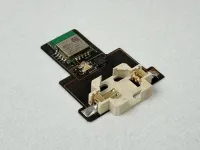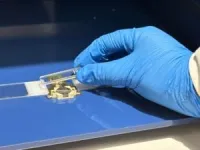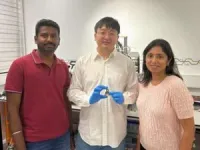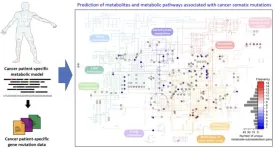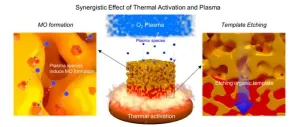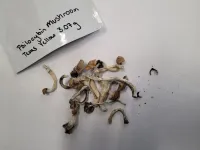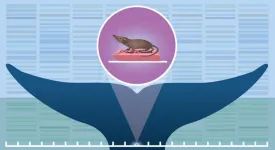Continuous non-invasive glucose sensing on the horizon with the development of a new optical sensor.
For decades, people with diabetes have relied on finger pricks to withdraw blood or adhesive microneedles to measure and manage their glucose levels. Researchers have taken an important step towards eliminating this discomfort.
2024-03-19
(Press-News.org)
For decades, people with diabetes have relied on finger pricks to withdraw blood or adhesive microneedles to measure and manage their glucose levels. In addition to being painful, these methods can cause itching, inflammation and infection.
Researchers at TMOS, the Australian Research Council Centre of Excellence for Transformative Meta-Optical Systems, have taken an important step towards eliminating this discomfort. Their RMIT University team has discovered new aspects of glucose’s infrared signature and have used this information to develop a miniaturised optical sensor only 5mm in diameter that could one day be used to provide continuous non-invasive glucose monitoring in diabetes management.
Non-invasive glucose sensing has been a target for almost 30 years due to its implications for pain free monitoring. Optical glucose sensing techniques have been reported; however, they require complex optical instrumentation usually found in laboratories, making them unsuitable for regular patient use.
The primary challenging facing affordable, wearable optical glucose testing has been miniaturisation and filtering out the glucose signals from water absorption peaks in the near infrared (NIR) spectrum. Essentially, it has been almost impossible to accurately differentiate between water and glucose in the blood. Until now.
In a first-of-its-kind research published in Advanced Sensor Research this week, the team has identified four infrared peaks in glucose that allow selective and sensitive identification in aqueous and biological environments. The team is keen to collaborate with academic and industry partners to continue this work and conduct pre-clinical and clinical research, which would open the door to the development of wearable optical glucose sensors.
The team has fabricated a miniaturised glucose sensor established on a 1600-1700nm waveband that is Bluetooth enabled and operates using a coin battery, which allows for continuous glucose monitoring. This compact sensor has demonstrated its viability detecting glucose levels in the human body range from 50 to 400mg/dL in blood plasma, with a comparable limit of detection and sensitivity to larger, laboratory-based sensors. Its small dimensions could see it one day integrated into smart watches and other pain-free wearable health trackers.
Lead author, RMIT PhD scholar Mingjie Yang, says “Until now, there is no consensus on the unique spectroscopic signature of glucose, largely because the O-H bonds targeted in near-infrared (NIR) spectroscopy for glucose detection are also abundant in water. This similarity makes it challenging to distinguish between glucose and water signals, especially in complex biological fluids and tissues. We optimized spectroscopy setup and analysed transmittance to identify peaks unique to glucose. Our discovery finally provides the information necessary to move forward with miniaturised optical glucose sensing and we have developed a device prototype to suggest the foundation for futuristic non-invasive glucose sensor.”
The device prototype utilises a surface-mounted device light emitting diode (SMD LED) and circuits made of thin-film copper coated polymide (Cu/PI) only 110 microns thick developed with a laser patterning technology. The millimeter-scale and lightweight design of this device making it considerably more compact than traditional benchtop spectrophotometers. Furthermore, the flexible patch-like design offers the future possibility of direct reading as a wearable device on human skin.
The performance of the device has been rigorously evaluated using aqueous glucose solutions as well as in blood plasma. Computational analysis of light-skin interference has been conducted that indicate how the SMD LED will penetrate the skin. Simulation results suggest the promising locations for future exploration of optical glucose sensing in clinical setups.
TMOS Chief Investigator Madhu Bhaskaran says, “The non-invasive nature of optical glucose sensors has the potential to improve patient compliance, reduce discomfort, and lower the risks of infections associated with invasive glucose monitoring. With the right collaborators/partners and the right funding, this can represent an important shift towards continuous and pain-free glucose sensing.”
Wearable sensors, such as this one developed by TMOS researchers at RMIT, are part of Centre’s Meta Health Sensors Flagship Program—an applied research program dedicated to the development of meta-optical sensors for MedTech applications.
RMIT University has filed a patent application related to the optical glucose sensor technology that the team developed.
For more information about this research, please contact connect@tmos.org.au
END
ELSE PRESS RELEASES FROM THIS DATE:
2024-03-19
A new study in people undergoing surgery to treat seizures related to epilepsy shows that pauses in speech reveal information about how people’s brains plan and produce speech.
Led by researchers at NYU Grossman School of Medicine, the study results add to evidence that neighboring brain regions, the inferior frontal gyrus and the motor cortex, play an important role in such planning before words are said aloud. Both are part of the folded top layers of the brain, or cerebral cortex, which has long been known to control the muscle (motor) movements in the throat and mouth needed to produce speech. Less ...
2024-03-19
Cancer is characterized by abnormal metabolic processes different from those of normal cells. Therefore, cancer metabolism has been extensively studied to develop effective diagnosis and treatment strategies. Notable achievements of cancer metabolism studies include the discovery of oncometabolites* and the approval of anticancer drugs by the U.S. Food and Drug Administration (FDA) that target enzymes associated with oncometabolites. Approved anticancer drugs such as ‘Tibsovo (active ingredient: ivosidenib)’ and ‘Idhifa (active ingredient: enasidenib)’ ...
2024-03-19
Imaging being able to wear your smartphone on your wrist, not as a watch, but literally as a flexible band that surrounds around your arm. How about clothes that charge your gadgets just by wearing them? Recently, a collaborative team led by Professor Jin Kon Kim and Dr. Keon-Woo Kim of Pohang University of Science and Technology (POSTECH), Professor Taesung Kim and M.S./Ph.D. student Hyunho Seok of Sungkyunkwan University (SKKU), and Professor Hong Chul Moon of University of Seoul (UOS) has brought a step closer to making this realty. This research work was published in Advanced Materials.
Mesoporous ...
2024-03-19
A five-day course of once-daily inorganic nitrate reduces the risk of a serious complication following a coronary angiogram, in which the dye used causes damage to the kidneys. The clinical trial, led by Queen Mary University of London and funded by Heart Research UK, also showed that the five-day course improves renal outcomes at three months and major adverse cardiac events (MACE) at one year compared to placebo.
Contrast-induced nephropathy (CIN), also known as contrast associated acute kidney injury (CA-AKI), is an uncommon but serious complication following ...
2024-03-19
EMBARGOED FOR RELEASE
6 p.m. PT / 9 p.m. ET, March 18, 2024
To coincide with publication in The Gerontologist
Media Contact: Suzanne Leigh (415) 680-5133
Suzanne.Leigh@UCSF.edu
Subscribe to UCSF News
People with dementia and those who care for them should be screened for loneliness, so providers can find ways to keep them socially connected, according to experts at UC San Francisco and Harvard, who made the recommendations after finding that both groups experienced declines in social well-being as the disease progressed.
The patients, whose ...
2024-03-19
Since the 1970s, the federal government has listed the active ingredients in mushrooms—psilocybin and psilocin—as illegal and having no accepted medical use.
However, in recent years, medical professionals have found that these substances are safe and effective for treating stubborn conditions such as treatment-resistant depression and post-traumatic stress disorder. Some jurisdictions now allow for the medical use of mushrooms, while others are considering permitting or at least decriminalizing their recreational use.
Clinicians now find themselves needing to carefully ...
2024-03-19
Irvine, Calif., March 18, 2024 — A research team led by the University of California, Irvine has discovered the key role that the APOBEC3A and APOBEC3B enzymes play in driving cancer mutations by modifying the DNA in tumor genomes, offering potential new targets for intervention strategies.
The study, published today online in the journal Nature Communications, describes how the researchers identified the process by which APOBEC3A and APOBEC3B detect specific DNA structures, resulting in mutations at distinct positions within the tumor genome.
“It’s critical to understand how cancer cells accumulate mutations leading to ...
2024-03-18
The blue whale genome was published in the journal Molecular Biology and Evolution, and the Etruscan shrew genome was published in the journal Scientific Data.
Research models using animal cell cultures can help navigate big biological questions, but these tools are only useful when following the right map.
“The genome is a blueprint of an organism,” says Yury Bukhman, first author of the published research and a computational biologist in the Ron Stewart Computational Group at the Morgridge Institute, an independent research organization that works in affiliation with the University of Wisconsin–Madison in emerging fields ...
2024-03-18
Water pollution from dyes used in textile, food, cosmetic and other manufacturing is a major ecological concern with industry and scientists seeking biocompatible and more sustainable alternatives to protect the environment.
A new study led by Flinders University has discovered a novel way to degrade and potentially remove toxic organic chemicals including azo dyes from wastewater, using a chemical photocatalysis process powered by ultraviolet light.
Professor Gunther Andersson, from the Flinders Institute for NanoScale Science and Technology, says the process involves creating metallic ‘clusters’ of just nine gold (Au) atoms chemically ‘anchored’ ...
2024-03-18
*This is an early press release from the European Congress on Obesity (ECO 2024) Venice 12-15 May. Please credit the Congress if using this material*
Food companies’ sponsorship of children’s sports may encourage children to buy their products, new research to be presented at the European Congress on Obesity (ECO 2024) (Venice 12-15 May), has found.
The Canadian research also found that many children view food companies that sponsor or give money to children’s sports as being “generous” ...
LAST 30 PRESS RELEASES:
[Press-News.org] Continuous non-invasive glucose sensing on the horizon with the development of a new optical sensor.
For decades, people with diabetes have relied on finger pricks to withdraw blood or adhesive microneedles to measure and manage their glucose levels. Researchers have taken an important step towards eliminating this discomfort.
